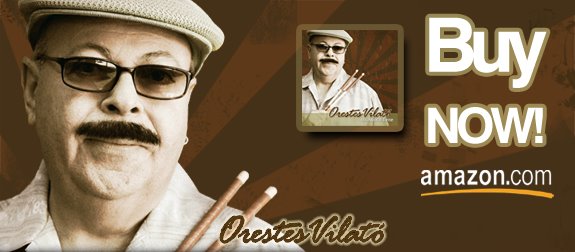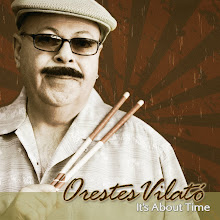24-feb 16:57
Chatting with the Cuban-born, N.Y.-bred titan of timbales is like opening a history book of Latin music.
By Reed Johnson
February 4, 2009
Chatting with Orestes Vilató is like taking a verbal walking tour of a half-century of Latin music. Pluck a name from the annals of salsa, Latin rock, Cuban roots music or Latin jazz and the odds are strong that this Cuban-born, New York-bred percussionist has tapped out polyrhythms alongside them: Aretha Franklin, Carlos Santana, Celia Cruz, Rubén Blades, Johnny Pacheco, La Lupe, McCoy Tyner, Linda Ronstadt and, of course, mambo king and nonpareil bassist Israel "Cachao" López.
FOR THE RECORD:
Orestes Vilato: An article in Wednesday's Calendar section on percussionist Orestes Vilato referred to Tito Puente as Cuban. Puente was born in New York City to Puerto Rican parents. —
Among Vilató's most influential accomplishments are virtually reinventing the art of playing the Cuban timbales and godfathering the birth of East Coast salsa.
So, all things considered, it's probably for the best that he never learned how to hold a guitar properly.
"This is how it started," says Vilató, 64, warming to a familiar narrative during a recent L.A. stopover from his East Bay home to promote his new album, "It's About Time." He'll perform tonight at the Catalina Bar & Grill in Hollywood.
"My father went to New York from Cuba at the age of 16 and studied opera, became a professional opera singer, then went back to Cuba, married my mother. But he had the classical training. So he had a little guitar made for me when I was about 5, 5 1/2 , 6. And I got a teacher and studied for a couple of months. All of a sudden, he comes home and sees me turning around the guitar and playing bongos on the back of the guitar. That was the beginning of my percussion career."
Like many of Vilató's fulsome supply of anecdotes, this one has been retold time and again. But coming from the Camagüey native, a warm, jovial man with the compact solidity of a conga, practically every story sounds freshly minted. Music aficionados know him as the most esteemed and oft-imitated living timbalero, but an hourlong conversation confirms that Vilató also is a raconteur of the first rank.
His sociability and skilled hands have placed him in constant demand as a collaborator since he was a teenager. Accustomed to plugging into a variety of musical styles and sensibilities and generous in appraising the talents of his artistic peers, he's now taking satisfaction in pulling off a project that bears his own personal stamp from start to finish.
"I've recorded with everybody and done everything," he says, "and I even have my own group in New York, but never did a solo album. Which is difficult, because the whole concept, that whole responsibility, relies on me. But I'm very happy about the whole project. It's very simple, it's got a lot of honesty and heart."
The honesty derives from the authenticity of the songs' arrangements by Vilató and his producer, Rebeca Mauleón, whom Vilató met years ago when she was a flamenco dancer (she's also a rumbera, an ardent fan of Cuban music and percussion).
"She modernized the album and put it up to date," Vilató says. "Without losing the roots and losing the concept, she took it up to 2009."
As for the album's pulsing corazón, that comes from the artist's desire to retrace his steps back to his youth in the province of Camagüey. That's where Vilató first came to know the music of his Spanish-Afro-Caribbean heritage, before his father, transferred to New York by his employer, moved the family to the United States in 1956, when Vilató was 12.
Although Cuba's big bands and musicians seldom ventured out of Havana to the provinces in those days, Vilató absorbed their sounds over the airwaves, through radio. "I was listening to those guys from Buena Vista [Buena Vista Social Club] before they were called Buena Vista. I grew up listening to Compay Segundo and all those guys because . . . Camagüey is next to Oriente, and they're all from Oriente. So that's the music that nourished me as a kid."
He soaked up the influences of Cuban religious ceremonial drumming, derived from West African spiritual customs. "There's chants that I would consider that are like prayers. And each prayer has a different toque [touch], a different way of presenting that prayer."
That notion of communicative rhythm patterns, of course, surfaces both in music and in syncopated dancing styles ranging from the fandango to Fred Astaire's tap routines, Vilató says, emphasizing a pet theme: the essential unity and interpolation of all music, chasing around the globe.
Cuba's musical giants of the 1940s and '50s were drinking up Hollywood and Broadway musicals. The revival of traditional Cuban music that prefigured the Buena Vista Social Club craze likely began in the late 1970s, when Vilató and his Fania All Stars, among others, toured the island nation, (re-)introducing a sound that many Cubans had thought was extinct.
And Vilató says that as a New York adolescent he was shaped as much by American rock 'n' roll, by Ritchie Valens' "La Bamba" and the Diamonds' “Little Darlin,” as by the beats floating down the streets of Camagüey.
"We are closer than people think. We haven't gone or learned anything, everything has been there all along," he says.
These various strands gradually coalesced into a personal drumming style that was distinctly different from that of Cuba's other great timbalero, Tito Puente. "It just came out natural," Vilató says. "It's like your signature or your fingerprints are unique because they're yours. And even if I try to do something from somebody else, when I interpret it, it doesn't come out the same."
For "It's About Time," Vilató also drew on memories of family get-togethers where music always was a group effort. "My grandmother had a drawer and she used to take out the maracas, the claves, and my aunt took the guitar. And we grew up getting together and singing. Every time we got together we sang tunes and it was happiness, it was simplicity."
Remembrances of that sheer pleasure in making music with others has underscored Vilató's entire career. He expresses his gratitude in "It's About Time," in tracks such as "Camagüey (Huye, Huye)" and "Las Boinas de Cachao."
"This is actually a dream come true. This is a thing that I wanted to do before I say goodbye to the world."
http://www.latimes.com/entertainment/news/music/la-et-vilato4-2009feb04,0,5266049.story?track=rss
martes, 24 de febrero de 2009
Suscribirse a:
Enviar comentarios (Atom)
.jpg)


No hay comentarios:
Publicar un comentario